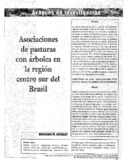| dc.description.abstract | En áreas de topografía de ladera y suelos de baja fertilidad localizados en la región centro dur del Brasil, las concentraciones de N y K en el forraje y en la hojarasca, de pasturas de Brachiaria decumbens y B. brizantha, aumentan cuando están asociados con especies de leguminosas arbóreas nativas. Se evaluó la tolerancia a la sombra de un grupo de gramíneas tropicales, introducidas debajo de un rodal de diferentes especies leguminosas. Las más tolerantes fueron B. brizantha cv. Marandu, Panicum maximum cv. Vencedor y B. decumbens, que alcanzaron una producción relativa en el área bajo la copa de los árboles de 98, 77 y 63%, respectivamente, respecto del área soleada. Se concluye que la asociación con leguminosas arbóreas fijadoras de N2 podrían contribuir para el desarrollo sostenible de pasturas de gramíneas prsentes en áreas montañosas de la región. In the mountainous area of the south central region of Brazil, where acid infertile soils predominate, the N and K concentrations in the forage and in the litter of Brachiaria decumbens and B. brizantha pastures increase. When they are associated with native legume tree species. The shade tolerance of a group of tropical forage grasses was examined, and it was observed that the most tolerant were B. brizantha cv. Marandu, Panicum maximum cv. Vencedor y B. decumbens, which under shade from a stand of different legume trees reached 98, 77 and 63%, respectively, of the dry matter yield obtained in full sunlight. It is concluded that the association with N2 fixing tree legumes may contibute to the sustainable development of the grass pastures that exist in this mountainous area. | es_ES |


